Seasonal promotions play a crucial role in enhancing visitor numbers and driving sales, particularly in the US, where businesses capitalize on holidays and special events. By creating attractive offers, retailers can increase foot traffic and online engagement, ultimately boosting brand visibility. To optimize these promotions, targeted outreach and strategic advertising, including effective email campaigns and social media engagement, are essential for maximizing impact during peak shopping seasons.
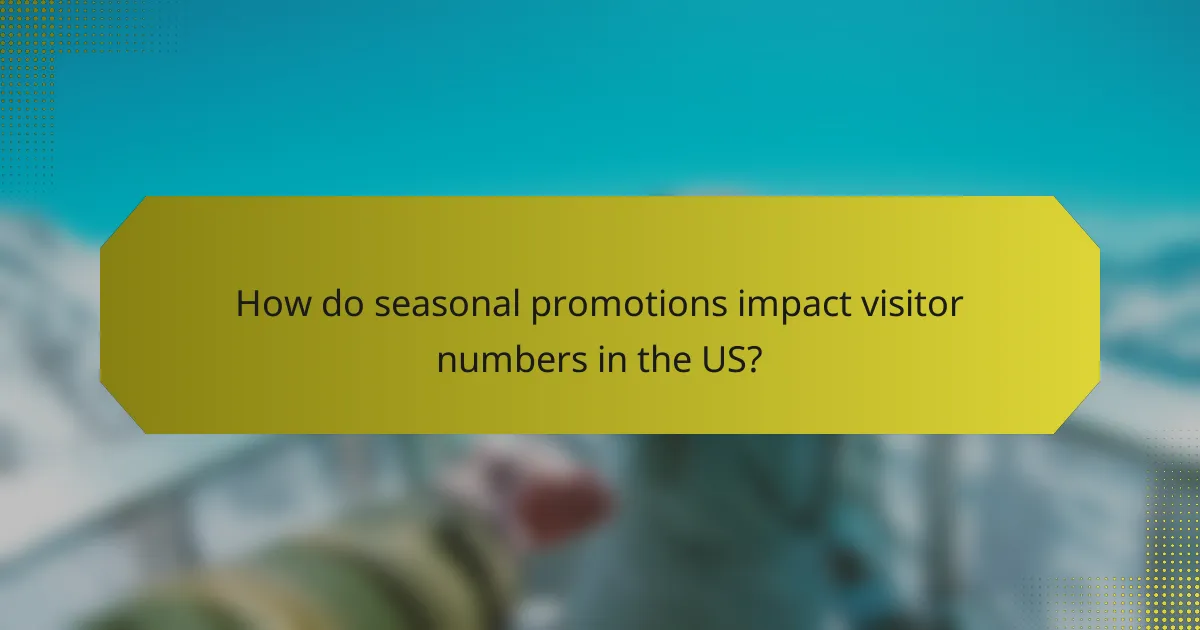
How do seasonal promotions impact visitor numbers in the US?
Seasonal promotions significantly boost visitor numbers in the US by attracting both foot traffic and online engagement. Retailers and businesses often leverage holidays and special events to create enticing offers that draw in customers, leading to increased sales and brand visibility.
Increased foot traffic during holidays
During holiday seasons, businesses typically see a surge in foot traffic as consumers seek out special deals and festive experiences. For instance, Black Friday and the weeks leading up to Christmas can result in a 20-30% increase in store visits compared to non-holiday periods.
To capitalize on this trend, retailers should consider extending store hours, enhancing in-store displays, and offering exclusive in-store promotions. Creating a festive atmosphere can also encourage shoppers to spend more time in the store.
Higher online engagement rates
Seasonal promotions can lead to significantly higher online engagement rates, with many businesses reporting increases in website traffic and social media interactions. For example, email marketing campaigns during holidays can achieve open rates of 20-30%, driving more visitors to online stores.
To maximize online engagement, businesses should focus on targeted marketing strategies, such as personalized email offers and social media ads that highlight seasonal promotions. Utilizing countdown timers for limited-time offers can also create a sense of urgency, encouraging customers to act quickly.

What strategies maximize seasonal promotions for affiliate marketers?
To maximize seasonal promotions, affiliate marketers should focus on targeted outreach and strategic advertising. Implementing effective email campaigns and leveraging social media platforms can significantly enhance visibility and engagement during peak shopping seasons.
Targeted email campaigns
Targeted email campaigns are essential for reaching specific customer segments during seasonal promotions. By segmenting your email list based on past purchases or interests, you can tailor your messages to resonate with each group, increasing the likelihood of conversions.
Consider using personalized subject lines and offers that reflect the season, such as holiday discounts or exclusive deals. A/B testing different email formats and content can help identify what resonates best with your audience, leading to higher open and click-through rates.
Social media advertising
Social media advertising allows affiliate marketers to reach a broad audience quickly, making it ideal for seasonal promotions. Platforms like Facebook, Instagram, and TikTok offer targeted ad options that can be customized based on user demographics, interests, and behaviors.
Utilize eye-catching visuals and seasonal themes in your ads to capture attention. Setting a budget for your campaigns and monitoring performance metrics will help you optimize your spending and maximize return on investment during critical shopping periods.

Which seasonal promotions are most effective in driving sales?
Seasonal promotions that effectively drive sales typically include limited-time discounts and bundled offers. These strategies create urgency and enhance perceived value, encouraging customers to make purchases during specific times of the year.
Black Friday discounts
Black Friday discounts are renowned for their ability to attract large crowds and boost sales significantly. Retailers often offer steep price reductions, sometimes ranging from 20% to 70% off, on popular items, making it a prime shopping day for consumers seeking deals.
To maximize the impact of Black Friday promotions, businesses should prepare in advance by analyzing past sales data and identifying high-demand products. Creating a sense of urgency through limited-time offers or exclusive deals can further entice shoppers to act quickly.
Holiday bundle offers
Holiday bundle offers combine multiple products at a discounted rate, appealing to consumers looking for value during the festive season. These bundles can increase average order value and simplify purchasing decisions, as customers perceive they are getting more for their money.
When designing holiday bundles, consider pairing complementary items that enhance the overall experience. For example, a tech retailer might bundle headphones with a smartphone at a reduced price. Ensure that the total discount is attractive enough to motivate purchases while still maintaining healthy profit margins.
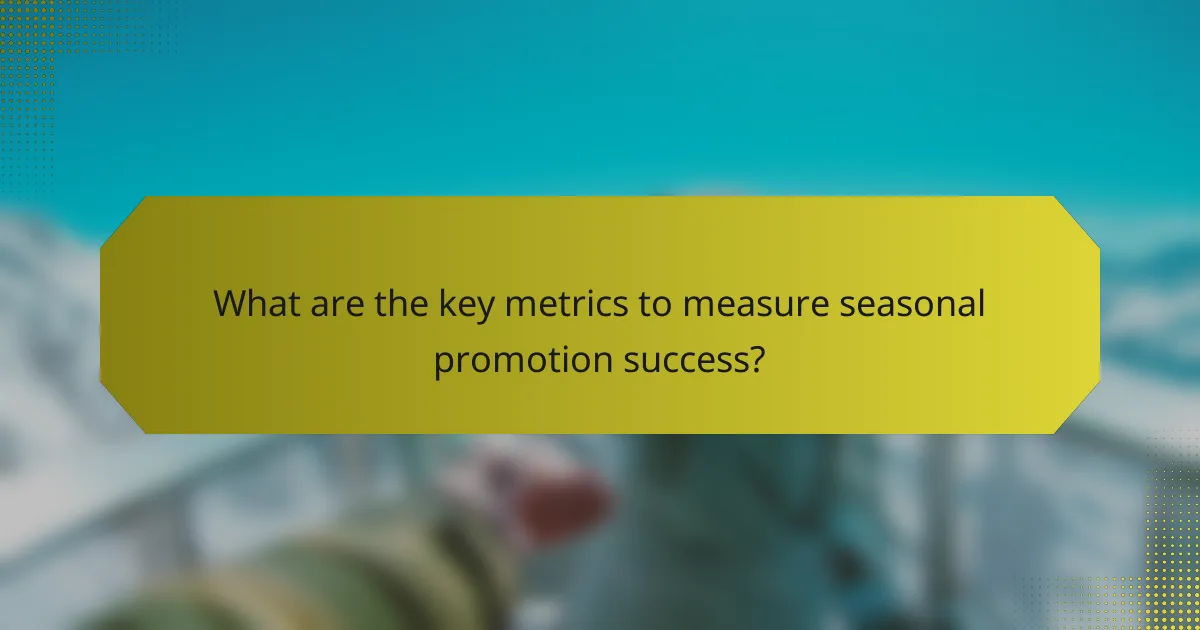
What are the key metrics to measure seasonal promotion success?
Key metrics for measuring seasonal promotion success include conversion rates and customer acquisition costs. These metrics provide insights into how effectively a promotion attracts and converts visitors into paying customers.
Conversion rates
Conversion rates indicate the percentage of visitors who complete a desired action, such as making a purchase during a seasonal promotion. A higher conversion rate suggests that the promotion effectively engages customers and encourages them to buy.
To calculate the conversion rate, divide the number of completed purchases by the total number of visitors, then multiply by 100. For example, if 200 out of 1,000 visitors made a purchase, the conversion rate would be 20%. Aim for conversion rates that are higher than your usual averages, especially during peak seasons.
Customer acquisition cost
Customer acquisition cost (CAC) measures the total cost of acquiring a new customer during a seasonal promotion. This metric includes marketing expenses, discounts, and any other costs associated with attracting customers. Keeping CAC low is crucial for maintaining profitability.
To calculate CAC, divide the total marketing spend by the number of new customers acquired. For instance, if you spent $1,000 on a promotion and gained 50 new customers, your CAC would be $20. Monitor CAC closely to ensure that promotional efforts remain financially viable, especially in competitive markets.
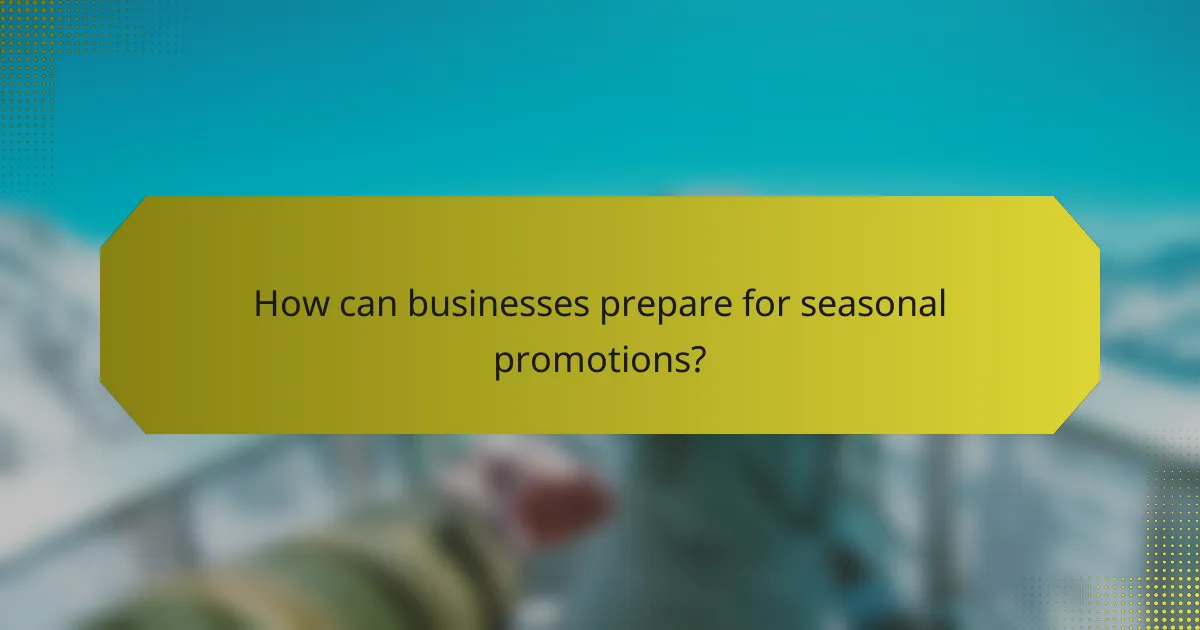
How can businesses prepare for seasonal promotions?
Businesses can prepare for seasonal promotions by strategically planning their inventory and marketing efforts. This involves analyzing past performance, forecasting demand, and aligning promotional activities with a well-structured marketing calendar.
Inventory management strategies
Effective inventory management is crucial during seasonal promotions to meet customer demand without overstocking. Businesses should assess historical sales data to identify trends and adjust stock levels accordingly, ensuring popular items are readily available.
Consider implementing just-in-time inventory practices, which can help minimize excess stock and reduce storage costs. Additionally, establish clear communication with suppliers to ensure timely restocking of high-demand products during peak seasons.
Marketing calendar planning
Creating a marketing calendar is essential for coordinating promotional activities throughout the year. Businesses should outline key seasonal events, holidays, and sales periods relevant to their target audience, allowing for timely campaign launches.
Incorporate a mix of marketing channels, such as social media, email, and in-store promotions, to maximize reach. Regularly review and adjust the calendar based on performance metrics to optimize future campaigns and avoid missed opportunities.
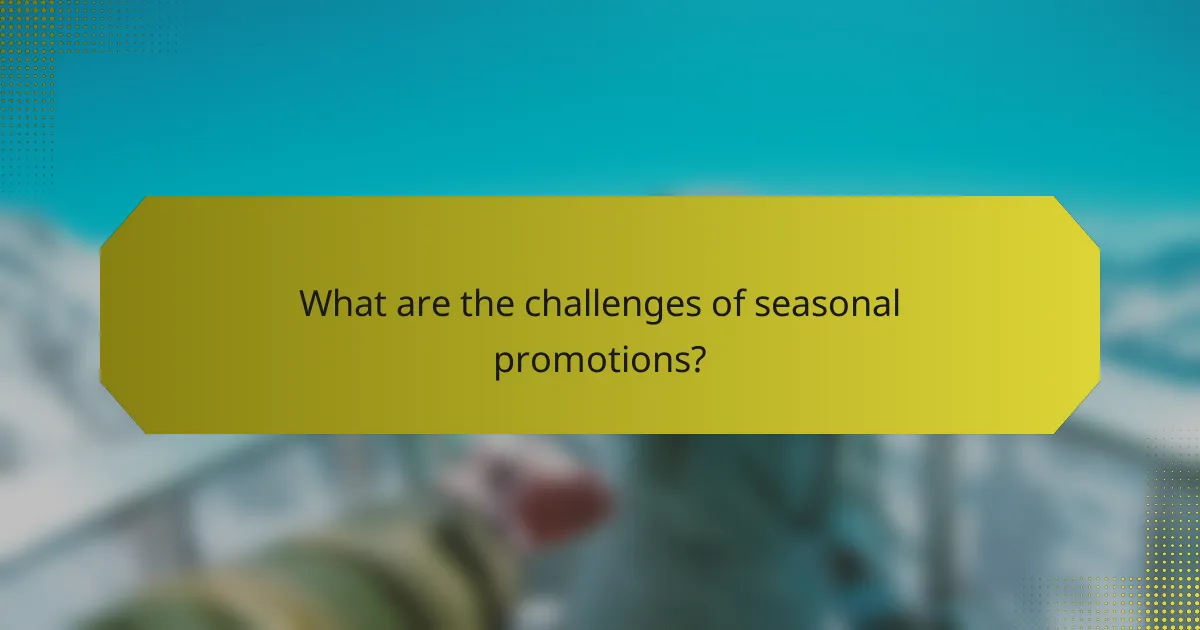
What are the challenges of seasonal promotions?
Seasonal promotions present several challenges that can impact their effectiveness and overall success. Key issues include market saturation, where many businesses offer similar deals, and budget constraints that limit promotional reach and creativity.
Market saturation
Market saturation occurs when numerous businesses launch similar seasonal promotions, making it difficult for any single offer to stand out. This can lead to diminished returns as consumers become overwhelmed by choices and promotional noise.
To navigate market saturation, businesses should focus on unique selling propositions (USPs) that differentiate their offerings. For example, instead of a generic discount, consider bundling products or providing exclusive experiences that resonate with the target audience.
Budget constraints
Budget constraints can significantly limit the scope and impact of seasonal promotions. Businesses may struggle to allocate sufficient funds for advertising, discounts, or enhanced customer experiences, which can hinder their promotional efforts.
To maximize impact within budget limitations, prioritize high-ROI channels such as social media or email marketing. Additionally, consider leveraging partnerships or collaborations to share costs and expand reach without overspending.
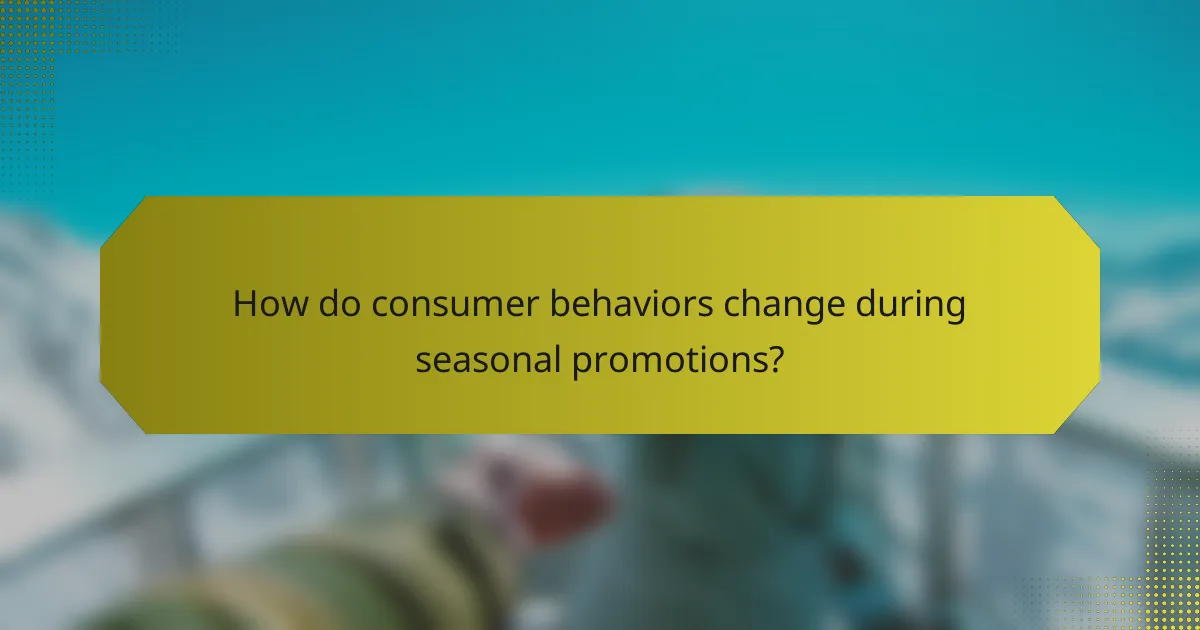
How do consumer behaviors change during seasonal promotions?
During seasonal promotions, consumer behaviors shift significantly as shoppers become more price-sensitive and motivated by discounts. This period often sees an increase in impulse buying, with many consumers actively seeking out deals and special offers.
Increased Price Sensitivity
Consumers tend to become more price-sensitive during seasonal promotions, looking for the best possible deals. This heightened sensitivity can lead to increased comparison shopping, where customers evaluate multiple retailers before making a purchase. Retailers should emphasize competitive pricing and highlight discounts to attract these bargain-hunting shoppers.
Impulse Buying Trends
Seasonal promotions often trigger impulse buying, as consumers are drawn to limited-time offers and perceived scarcity. Retailers can capitalize on this by creating urgency through countdown timers or highlighting low stock levels. Simple strategies like eye-catching displays and strategic product placement can further encourage spontaneous purchases.
Shift in Shopping Channels
During seasonal promotions, consumers may shift their shopping channels, with many opting for online purchases to take advantage of convenience and better deals. Retailers should ensure their online platforms are optimized for mobile devices, as a significant portion of shoppers will use smartphones to browse and buy. Additionally, integrating social media marketing can effectively reach consumers during these peak shopping times.


